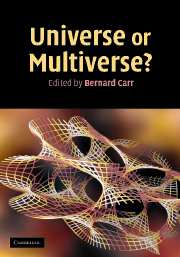Book contents
- Frontmatter
- Contents
- List of contributors
- Preface
- Acknowledgements
- Editorial note
- Part I Overviews
- Part II Cosmology and astrophysics
- Part III Particle physics and quantum theory
- 14 Quarks, electrons and atoms in closely related universes
- 15 The fine-tuning problems of particle physics and anthropic mechanisms
- 16 The anthropic landscape of string theory
- 17 Cosmology and the many worlds interpretation of quantum mechanics
- 18 Anthropic reasoning and quantum cosmology
- 19 Micro-anthropic principle for quantum theory
- Part IV More general philosophical issues
- Index
- References
19 - Micro-anthropic principle for quantum theory
Published online by Cambridge University Press: 05 July 2014
- Frontmatter
- Contents
- List of contributors
- Preface
- Acknowledgements
- Editorial note
- Part I Overviews
- Part II Cosmology and astrophysics
- Part III Particle physics and quantum theory
- 14 Quarks, electrons and atoms in closely related universes
- 15 The fine-tuning problems of particle physics and anthropic mechanisms
- 16 The anthropic landscape of string theory
- 17 Cosmology and the many worlds interpretation of quantum mechanics
- 18 Anthropic reasoning and quantum cosmology
- 19 Micro-anthropic principle for quantum theory
- Part IV More general philosophical issues
- Index
- References
Summary
Introduction
As a prescription for ascribing a priori probability weightings to the eventuality of finding oneself in the position of particular conceivable observers, the anthropic principle was originally developed for application to problems of cosmology [1] and biology [2]. The purpose of this chapter is to provide a self-contained introductory account of the motivation and reasoning underlying the recent development [3] of a more refined version of the anthropic principle that is needed for the provision of a coherent interpretation of quantum theory.
In order to describe ordinary laboratory applications, it is commonly convenient, and entirely adequate, to use a ‘Copenhagen’ type representation, in which a Hilbert state vector undergoes ‘collapse’ when an observation is made. However, from a broader perspective it is rather generally recognized that such a collapse cannot correspond to any actual physical process.
A leading school of thought on this subject was founded by Everett [4], who maintained the principle of the physical reality of the Hilbert state, and deduced that — in view of the agreement that no physical collapse process occurs — none of the ensuing branch channels can be ‘more real than the rest’. This was despite the paradox posed by the necessity that they be characterized by different (my italics) ‘weightings’, the nature of which was never satisfactorily explained. This intellectual flaw in the Everett doctrine was commonly overlooked, not so much by its adherents, who were seriously concerned about it [5], as by its opponents, who were upset by its revolutionary ‘multi-universe’ implications.
- Type
- Chapter
- Information
- Universe or Multiverse? , pp. 285 - 320Publisher: Cambridge University PressPrint publication year: 2007
References
- 4
- Cited by



